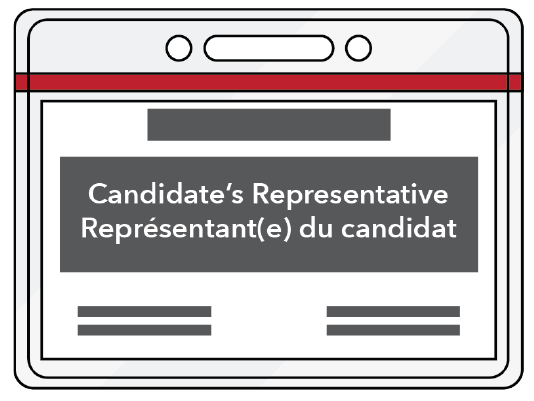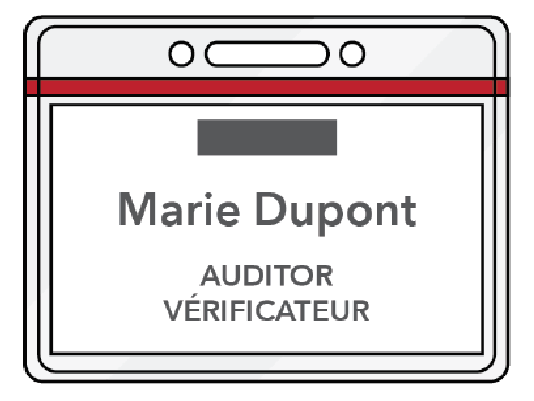Deputy Returning Officer & Poll Clerk Guidebook–Advance Polling Days
Good to Know
This section includes information you might need at any time.
Tips
- If you are facing a situation that isn't described in this guidebook, or you need additional help, see your CPS
- Your CPS will plan for breaks. Wait to be relieved before taking a break
Balancing Ballots
How do I balance my records and ballots?
When you balance your records and ballots using Log for balancing records and ballots — Events Log EC 50060, you are checking that your record of the number of people who have voted is correct and that none of your ballots are missing. By balancing often, you can find mistakes quickly. Some errors can be fixed, others cannot be fixed but balancing helps you make sure they don't get worse. Either way, balancing helps you to manage problems as soon as possible.
Things to keep in mind:
- If you receive additional ballots, you will have more than one Record of Ballots EC 10002. Add the totals
- When you count the Number of Electors on Record of Electors EC 50080, make sure you include all of them since voting started on Friday
- When you count the Spoiled ballots, make sure you include all of them since voting started on Friday. Envelopes from previous days will be sealed. Add the numbers written on the envelopes.
- The Total column should match the Total number of ballots box on Record of Ballots EC 10002
- Make sure you use the correct log
At advance polls there are two different ways to balance, depending on the situation. (age 73-74)
Balancing throughout each day: The quick method
Use the quick method to balance your records and ballots at least 4 times throughout each day of the advance poll, and after the polls close on Friday, Saturday and Sunday.
Use Log for balancing records and ballots - Advance Polling Days - Events Log EC 50060 (page 4-5).
- Both: In the first column, count and write the number of electors on all Record of Electors since voting started on Friday
- Both: In the second column, count and write the number of all spoiled ballots since voting started on Friday
- Both: In the third column, count and write the number of unused ballots
- Both: Add the numbers from the first three columns and write the total
Note it should match the Total number of ballots on Record of Ballots EC 10002
- Both: In the fifth column, write the date that you did the balancing
- Both: In the sixth column, write the time that you did the balancing
- Both: If you are leaving the polling station, in the seventh column, write your initials
If you are entering the polling station, in the eighth column, write your initials

Text version of "Log for balancing records and ballots - Advance Polling Days - Events Log (page 4-5)"
Balancing on Monday night: The detailed method
Use the detailed method to balance your records and ballots after voting has finished on Monday night.
Balance using Log for balancing records and ballots - Advance Poll (Monday night) - Events Log (page 6-7) EC 50060.
- Both: In the first column, count and write the number of all the ticks in the Voted boxes on List of Electors
- Both: In the second column count and write the number of all the ticks in the Voted boxes on List of Entries
- Both: In the third column, count and write the number of spoiled ballots
- Both: In the fourth column, count and write the number of unused ballots
- Both: Add the numbers from the first three columns and write the total in the fifth column
Note it should match the Total number of ballots on Record of Ballots EC 10002
- Both: In the sixth column, write the date that you did the balancing
- Both: In the seventh column, write the time that you did the balancing

Text version of "Log for balancing records and ballots - Advance Poll (Monday night) - Events Log (page 6-7)"
Problems with balancing
Ask your CPS for help. Try these steps:
- make sure you are using the correct page and counting the correct items for each column
- check the number of entries on the Record of electors. This should match the number of people voted, which is the sum of the two numbers below:
- check the number of electors who were on the list who voted by counting the number of entries on Sequence Number Sheet EC 50111
If there is still an imbalance, think of any events since you last balanced which may explain the reason for the imbalance.
Don't try to correct any of your records. Instead:
- Both: Record what you think is the reason for the imbalance in Log of notable events - Events Log (page 8-11) EC 50060 with as much detail as you can
-
Both: Write the line number of the notable event beside the relevant entry on Log for balancing records and ballots to show the link between the two entries
Note Next time you balance, if your numbers are off in the same way, you do not need to complete a new notable event

Text version of "Log of notable events - Events Log (page 8-11)"
Suspicious activities
- Both: Inform the CPS right away
- Both: Give them as much detail as possible, such as the person's name, address, time of incident and any statements made by that person
- Both: Follow their instructions
Some examples of suspicious activities include:
- destroying or removing electoral material or campaign signs
- trying to use a fake ballot or one that was not issued to the elector by the DRO
- leaving the polling place with a ballot(s)
- trying to register or vote when not eligible or encouraging someone else to do so
- trying to force someone to vote or refrain from voting
- being intimidating or violent towards someone
- spreading false or misleading information about candidates, political parties, when, where and ways to register and/or vote, or about qualifications to vote
- taking photos or video inside the polling place unless pre-authorized by the Chief Electoral Officer
- displaying campaign material inside a polling place
Cell Phones in the polling place
Electors, candidates or representatives can use their cell phones inside the polling place if they do not disturb others.
No one may record, film or take pictures inside the voting place. There is one exception: Electors with a disability are allowed to use their cell phone behind the voting screen as an assistive tool to help them vote — An elector needs extra help
Using the Voting Template
Electors with a visual impairment might want to vote using Voting Template EC 50170. The template allows them to vote independently.
You can get it from the CPS.
- DRO: Follow procedures as written on the back of Voting Template EC 50170
Tell them what you are doing at each step (e.g. I am now tearing up the counterfoil)
- DRO: Serve elector following regular process — When an elector arrives
Note visually impaired electors are allowed to hold their ballot while you check the serial number and remove the counterfoil
Candidates' representatives

Text version of "Candidate's Representative badge"
Candidates and representatives must wear the badge shown above. They must sign in with the CPS at each polling place they visit.
Their main contact is the CPS, who can ask them to leave or have them removed if they don't follow Guidelines for Candidates' Representatives EC 20045.
They must stay neutral in the polling place, and they must respect the secrecy of the vote.
Up to 2 representatives per candidate are allowed at your polling station at a time.
- they can sit near to your table. They cannot sit at it
- they can ask the elector to see their ID, but only when the DRO asks to see it. They cannot touch an elector's ID
- they can review the documents at your table
- they may interrupt the voting process to express doubt about an elector's qualification to vote, but only before the ballot is issued
- Both: Ask to see their badge. If they don't have it, send them to the CPS
- Both: Show them where they can sit
If you have any questions about the behaviour of candidates or representatives, talk to the CPS
Visitors

Text version of "Visitor's badge"
Elections Canada authorizes visitors. They must wear the badge shown above.
Their main contact is the CPS.
They must stay neutral in the polling place, and respect the secrecy of the vote.
They might be alone or in a group. They might be observing any aspect of the polling place. They will not interrupt you or the voting process, but they might ask questions if you are not busy.
- Both: Ask to see their badge. If they don't have it, send them to the CPS
- Both: Show them where they can sit
If you have any questions about the behaviour of visitors, talk to the CPS
Auditors

Text version of "Auditor's badge"
The Canada Elections Act requires that an audit take place to ensure compliance with the procedures at polling places. An auditor may come to your polling place.
Elections Canada authorizes auditors. They must wear the badge shown above. Their main contact is the CPS. They must stay neutral in the polling place, and respect the secrecy of the vote.
Auditors usually work alone. They are observing voting procedures and reviewing the records being kept. They may observe at polling stations and at registration desks. They will not interrupt you or the voting process.
- they may circulate freely within the polling place
- they may sit close to your table so that they can observe properly
- they may examine an elector's ID documents, but they cannot handle them
- they may review the documents at your table without interrupting the voting process
- they may ask you questions
- they will be making notes, on paper or on a laptop or a tablet
- Both: Ask to see their badge. If they don't have it, send them to the CPS
- Both: Show them where they can sit
If you have questions about procedures, ask the CPS, not the auditor. If you have any questions about the behaviour of auditors, talk to the CPS
Feedback, concerns or complaints
If someone has feedback, a concern or a complaint:
- take it seriously
- if it is something you can address easily and quickly, address it, then tell the CPS
- if you cannot address it easily and quickly, tell or direct the person to the CPS
There is traffic or lineups
- Both: Ask electors waiting at your desk to stand behind the line
- Both: Politely ask electors who have voted to leave
- Both: If traffic persists, ask the CPS for help
Workplace harassment and violence
Elections Canada upholds a zero tolerance policy on workplace harassment and violence.
The CPS is designated to receive, document and report incidents happening at the polling place.
See the CPS if you witness or are a victim of harassment or violence
